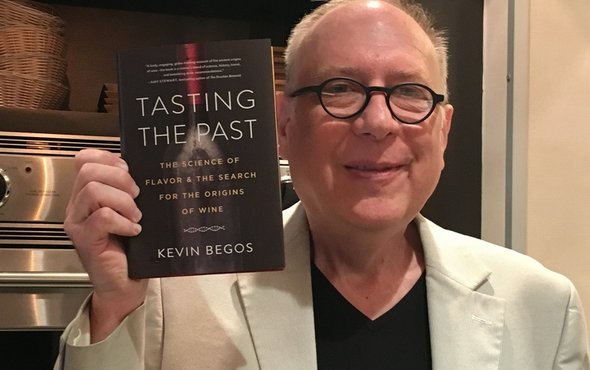(单词翻译:单击)
听力文本
This is Scientific American — 60-Second Science. I'm Steve Mirsky.
Got a minute?
"The general public, if you look at the broad numbers, it's like 60 percent of vineyards around the world, in the New World, have been planted with just five or six varieties of grapes in the last 10 or 20 years. From the Australians to New Zealand to, of course, all of California."
Science journalist Kevin Begos, the author of the new book Tasting the Past: The Science of Flavor and the Search for the Origins of Wine. He spoke in June at Astor Wines and Spirits in Manhattan. At one point he talked about disease threats to wine grapes.
"So the scientists are starting to get really concerned that this is setting up a perfect scenario for a grape pandemic. Which would seem a little far-fetched, except...we all know that grapes are being reproduced by cuttings, not by seed, to keep the flavor qualities. What that means is they haven't been evolving for hundreds or thousands of years. Pinot is 2,000 years old, which is kind of the general estimate."
"Since we've been cloning it to keep the flavors for roughly 2,000 years, all the insects and pathogens and mildews that attack grape vines have been evolving that whole time. They always figure out new ways to attack the grape vines..."

"Wine grape researchers at the leading institutions are saying, look, you're doing the exact same thing they did during the Irish potato famine, which was plant the same variety of potato all over Ireland, propagate it just from buds, from the shoots coming out of old potatoes. And then when a fungus hit it, it wipes out the whole population. So these are not just hypotheticals..."
"So I don't want to be unduly alarmist, because this could be 50 years down the road, it could be 100 years down the road."
Or it could be prevented. Because other grapes, which have not been popular for wide-scale winemaking have kept evolving. And some of these have natural disease resistance. Crossing these wine grape varieties with more popular ones could head off a pandemic before it happens. You can hear more of Kevin Begos's talk about wine on an upcoming episode of the longform Scientific American podcast Science Talk.
For Scientific American — 60-Second Science. I'm Steve Mirsky.
参考译文
这里是科学美国人——60秒科学。我是史蒂夫·米尔斯基。
“如果公众看一下大体数据,就会发现在过去10到20年里,全世界、美洲大陆约60%的葡萄园只种植五六种葡萄。从澳大利亚到新西兰,当然还有整个加州都是如此。”
科学记者凯文·毕高斯说到,他最近出版了新书《品味过去:风味的科学及红酒来源探寻》。今年6月,他在曼哈顿的“阿斯托葡萄酒和烈酒”商店发表了讲话。他一度谈到威胁酿酒葡萄的疾病。
“因此,科学家开始真正关注为葡萄流行病设计一个完美的解决方案。这似乎有点儿难以置信,除了……我们都知道,为了保持葡萄的风味质量,葡萄是通过插枝而不是播种来繁殖的。这意味着他们有数百甚至数千年都没有进化。据大概估计,比诺葡萄已经有2000年的历史了。”
“为了维持其风味,我们近2000年来一直在克隆比诺葡萄,但是所有损害葡萄藤的昆虫、病原体和霉菌却一直在进化。它们总能找出新方法来损害葡萄藤……”
“领导机构的酿酒葡萄研究人员说,看,你们现在的做法和爱尔兰大饥荒时期一样,当时人们在爱尔兰各地种植同一种土豆,用老土豆上钻出的芽来培植新土豆。然后当真菌来袭时,所有土豆都绝收。因此这些并不只是假设。”
“我不想成为过分的危言耸听者,因为这可能是50年之后的事情,也可能在100年后才发生。”
或者我们可以避免这种情况的发生。因为其他尚未在大规模葡萄酒酿制业中流行起来的葡萄品种一直在不断进化。其中一些品种具有天然的抗病能力。将这些酿酒葡萄品种与更流行品种进行杂交,可以阻止流行病爆发。大家可以关注《科学美国人》的加长版播客《科学对话》即将播出的节目,收听凯文·毕高斯对葡萄酒的更多见解。
谢谢大家收听科学美国人——60秒科学。我是史蒂夫·米尔斯基。
译文为可可英语翻译,未经授权请勿转载!
重点讲解
重点讲解:
1. figure out 想出;理解;弄清;
I can't figure out how to do this.
我弄不懂怎样做这件事。
2. all over 到处;遍及;
We have friends all over the world.
我们的朋友遍天下。
3. wipe out 摧毁;毁灭;使灭绝;
Last year's profits were virtually wiped out.
去年的利润几乎全都赔光了。
4. head off 阻止,防止(尤指不愉快的事)发生;
He would ask Congress to intervene and head off a strike.
他将要求国会进行干预,防止发生罢工。


